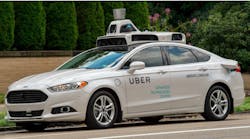I have seen the future of land transportation, and it’s both fascinating and freakish.
While in Pittsburgh recently, I requested an Uber. Minutes later, my wife and I were surprised to see a gray SUV roll up with a LIDAR (light detection and ranging device) on the roof — a driverless car.
Well, sort of.
In the front seat were two Uber staffers, one behind the wheel and the other in the passenger seat with a large laptop that exhibited a real-time, three-dimensional map of the surroundings. The two greeted us warmly, said “buckle up,” and told us why they were in the vehicle.
The “driver” was occasionally driving, possibly due to our location. Pittsburgh is a notoriously difficult city to navigate, and the Strip District, where the Uber picked us up, has its own challenges, especially on a Friday afternoon. Loaded with restaurants and specialty food markets, the area was a jumble of residents on foot and in cars, stocking up on eats for the weekend. One-way streets, narrow alleys, and a shortage of parking frustrate drivers and the driverless alike.
There also were a number of detours required for our short journey downtown, which may have forced the Uber onto routes not previously mapped for driverless access. Our driver believed one street was blocked due to the filming of a movie; I asked if it was Attack of the Driverless Cars.
Positioned between the two front seats was a tablet on which we could see our progress amid color-coded moving cars, walking pedestrians, buildings, streetlights, etc. The LIDAR casts light against these objects, building a dataset from which the speed and trajectory of objects can be calculated — and appropriate driverless Uber reactions can be determined. (We were told that the car costs around $75,000, with another half million dollars in technology thrown in). The tablet also contained a camera for selfies, which we used — although the images were never emailed to us (maybe because I feigned terror).
Our companions said the driverless Uber is far more polite than any human driver, always stopping for pedestrians and yielding to vehicles, even when the Uber has the right of way. For example, a woman at the side of the car looked ready to step into traffic, so the car stopped. One staffer indicated that the system doesn’t have issues with weather, although snow can sometimes be interpreted as boulders falling from the sky. Hmmm. And on at least one occasion, our human driver was summoned to take over, but wasn’t quite sure why.
We safely and quickly reached our destination. I found it to be a great, albeit brief experience. Would I have felt the same without our guides in the front seats? Maybe not, but then I soon had something with which to compare our high-tech transport.
Our Uber ride back to the Strip District was in a regular car with a human driver. It was neither pleasant nor interesting. The driver was late, represented by the little car icon aimlessly circling blocks away and the minutes to our pickup increasing. When the Uber finally got into view, the driver waved and asked us to cross a large, rush-hour intersection instead of making a left to pick us up. (By this time we had reached him by phone, and told him we weren’t moving). The driver took a clever route to get us to the Strip District, but then drove down an alley and became stuck behind a produce truck. Sheepishly, he insisted that this was the destination shown on his tablet. We got out more than a block from our intended dropoff.
Where’s a driverless Uber when you need one?
George also serves the Lean Enterprise Institute (LEI), for which he develops lean case studies and manages and/or edit book projects, including Gemba Walks by Jim Womack (LEI, 2011) and The Lean Manager by Michael Ballé and Freddy Ballé (LEI, 2009).
He writes one of a series of blogs provided to IndustryWeek by The MPI Group




